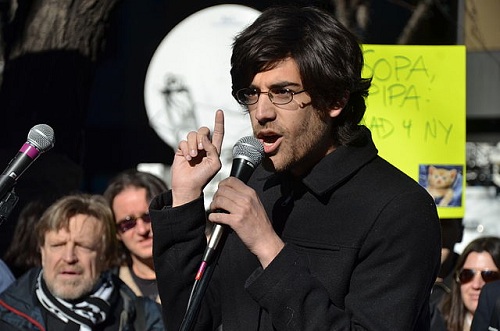We all worry about plagiarism, which is a type of theft of intellectual property. But theft of that nature covers a lot of things – any misuse of copyright protected material. Usually, we think it’s an act of a desperate or lazy person – perhaps a weak or struggling student looking for a quick fix. That isn’t always the case, though.
Recently, a man named Aaron Swartz has been in the news. An Internet pioneer, Swartz has been involved in developing Rich-Site Summary (RSS) feeds (from which you might be monitoring this blog) and Creative Commons licensing (from which the accompanying photograph, taken by Daniel J. Sieradski, comes), campaigned against the SOPA legislation, and been a prominent defender of civil liberties on the web. And then, when he was a research fellow at Harvard, he downloaded millions of copyright-protected articles from the database JSTOR with the intent to make them freely available on the web. Federal prosecutors brought more than a dozen felony charges against him. And earlier this year, under the threat of up to fifty years in prison, Swartz hanged himself.
While Swartz was unquestionably guilty of violating JSTOR’s terms of use, there is a significant controversy over whether he committed, or should have been charged with, a felony. Even JSTOR opposed his criminal prosecution after they got their data returned to them. But this incident has left a lot of people at colleges and universities nervous. After all, we ask you to use a lot of resources for your classes. We do ask you to cite them. But what actually constitutes ‘fair use’? When are you safe?
Well, unfortunately, most fair use law is case law – precedent created through court rulings – rather than code law – clear law written by legislators. So fair use can be hard to define. For the most part, we weigh factors relating to our use – certain uses are more likely to be seen favorably by the courts. Others are more likely to get us into trouble.
When you’re using anything that someone else owns or created, ask yourself questions like this:
- Are you using the content for school? If so, you’re safer. If not, you’re less safe.
- Are you making a profit on it? If so, you’re less safe. If not, you’re safer.
- Are you damaging the owner’s ability to make a profit on it? If so, you’re less safe. If not, you’re safer.
- Is the project you’re using it for a work of satire? If so, you’re safer. If not, you’re less safe.
- Are you significantly transforming the work – that is, is what you make going to be radically different in purpose and use that the work you used? If so, you’re safer. If not, you’re less safe.
- Have you given credit to the owner? If so, you’re safer. If not, you’re less safe.
Copyright expert Kenneth D. Crews, while he worked at IUPUI, wrote up a list of criteria containing these and other questions, and now many colleges and universities use that for gauging the safety of using copyrighted work. So whenever you’re about to use something under copyright for a project or presentation, take a look at the checklist and make sure your use is safe!
If you have any questions, please contact us at iueref@iue.edu.


